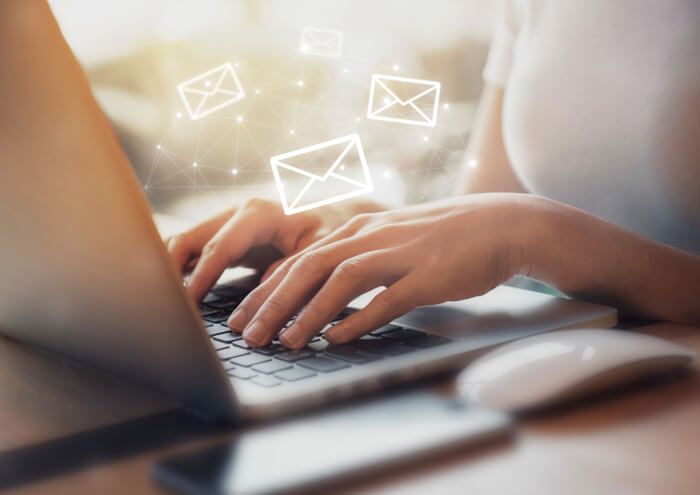The reminder e-mail, a marketing and strategic object.
 It is estimated that more than 270 billion e-mails are sent worldwide every day. This is far more than the daily volume of text messages, which is limited to 200 billion (quite an achievement, nonetheless).
It is estimated that more than 270 billion e-mails are sent worldwide every day. This is far more than the daily volume of text messages, which is limited to 200 billion (quite an achievement, nonetheless).So how can we not ask ourselves the following question: What can I do to make my e-mail more attractive, more disruptive so that it is opened and read?
If we focus on the field of debt collection and customer reminders, this medium is still the one that allows you to deal with volume with a formidable efficiency. However, it is important not to lose sight of the objective: sending large quantities of e-mails is not an end in itself, the main objective is to obtain a response or payment from the customer. It is then necessary to know how to write it, when to write it and to whom to send the message. Knowing how to answer these 3 questions means understanding that email is only a means to an end, not an end in itself.
Your e-mail is a vector that conveys your image and that must allow you to reach your objective.
Let's start by breaking down the steps that will make your follow-up e-mail a strategic tool.
The subject line is an essential element.
Indeed, it is the second piece of information, after the sender, that your recipient will read. The subject line is what will encourage the recipient to open your message and be interested in the content. So the more relevant the subject line, the higher the open rate.
Here are some basics to have an interesting e-mail subject:
- Use of keywords
- Putting forward the essential
- Arouse curiosity
- Avoid the "novel river" because not everything will be visible at a glance
- Do not use words like Urgent / Dunning / Nth Dunning / Unpaid...
You have to think of your customer reminder strategy as an e-mailing campaign: the product you are selling is the trigger for your customer's desire to pay or to respond.
We now come to the text or body of the e-mail:
The personalization of the e-mail remains in the pool position of the successful reminder: you must show your interlocutor that you know him, you must try to weave a link with the recipient.
Remember your French writing lessons: you must structure your text: introduction and development. Do not make long complicated sentences, always think simplification. You must give space, freedom in your presentation by airing the text. No spelling or syntax mistakes. Appropriate punctuation (no exclamation marks!)
There is one more step: the conclusion of the message.
How do I end my e-mail?
If we keep in mind that the objective of your dunning e-mail is to get a response or to trigger a payment, it is imperative that your recipient be led to act. So you must clearly ask for an action which can take different forms depending on the objective:
- Ask for a confirmation (in the case of a promise)
- Request a response (in the case of an identified dispute)
- Ask for a payment (in the case of a reminder).
The notion of deadline / date must be introduced to bring your interlocutor to a better commitment.
We can therefore see that there are 4 categories of reminder e-mails:
- Follow-up e-mails with a fixed structure (but perfectly written) for automatic or automatic sending to be confirmed
- Customizable e-mails that are more oriented towards your strategic customers
- Interactive e-mails for a service/customer contribution while mixing automatism or personalization
- Follow-up e-mails for disputes or promises of settlement.
We have only answered one question out of the 3, "how do I write my reminder e-mail?"
There are 2 other important questions left, which are "when to write it and who to send it to?"
The timing to send a dunning e-mail depends totally on the strategy put in place to manage your customer accounts: is there an action taken before the due date of the invoice? From how many days late do I start my reminder? How do I identify possible disputes? What sequence is used in my dunning scenario? How do I alternate the media I use (e-mail, interactive e-mail, sms, telephone, visits, etc.) In addition to these different questions, I need to know who I am addressing. In a future article, we will communicate some best practices to answer these questions.
Cash collection is an art that relies on techniques.
In the current context where digital technology takes a prominent place in our daily lives, it is essential for recovery professionals to adapt their methods. The digitalization of customer follow-ups then appears to be the appropriate solution to effectively manage this growing workload.
- Saves time: By automating tedious and repetitive tasks such as sending standard e-mails, cash collectors can focus on negotiation, complex problem solving and decision making.< /li>
- Optimization of resources: The credit management team can therefore work more efficiently and avoid additional costs.
- Increased efficiency: The different stages of order to cash process are formalized and structured using digital tools, allowing better monitoring of customers and performance.
It is essential to have the tool that allows you to exploit your art at best with an irreproachable technical support allowing you to improve the satisfaction of your customers while ensuring the conquest of your cash.
My DSO Manager, your credit management software brings you this dimension to transform your reminder e-mails into marketing objects and accompany you in the implementation of a strategy that optimizes your performance.